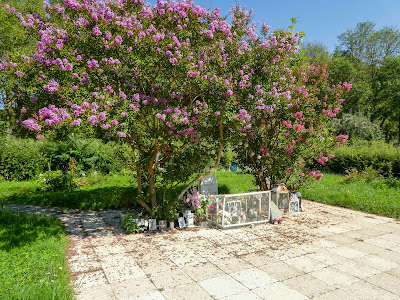Dr. Arlene Keizer is Professor and Former Chairperson of the Department of Humanities and Media Studies at Pratt Institute in NYC. She is a scholar in the fields of literary and cultural studies who writes about the literature, lived experience, theory, and visual art of the African Diaspora.
Dr. Keizer graciously granted Les Amis this interview as a prelude to the release of Fraternal Light: On Painting While Black, her book of poems inspired by Beauford's life and work. In Part 2 of this blog post, she discusses several of Beauford's works that inspired her poetry.
Fraternal Light book cover
Cover art by Nell Painter
Les Amis: In the panel discussion called “Red Summer Remembered: Cultural Trauma and Commemorative Art Practices” that you organized in 2019, you discussed three Beauford Delaney paintings in relation to the 1919 Knoxville Race Riot that took place during Red Summer. In your Speaking of Marvels interview, you identify two Beauford Delaney paintings that inspired the poem “Terror in the Heart of Freedom.” Please share a list of the paintings that inspired the poems in Fraternal Light and other areas of your work focused on Beauford.
AK: Here is the list:
Untitled (Knoxville Landscape), 1922, watercolor on paper
Untitled (Knoxville Landscape)
(1922) Gouache on paper
© Estate of Beauford Delaney
by permission of Derek L. Spratley, Esquire,
Court Appointed Administrator
Knoxville Landscape, 1969, mixed media on paper
Harlem Blue, exhibited February 1949 (This is likely the same painting sold by Swann Auction Galleries as Untitled (Village Street Scene) in 2018.)
Dark Rapture (James Baldwin), 1941, oil on Masonite
Abstraction #12, 1963, oil on canvas
Moving Sunlight, 1965, oil on canvas
Moving Sunlight
(1965) Oil on canvas
Knoxville Museum of Art, 2018 acquisition
© Estate of Beauford Delaney
by permission of Derek L. Spratley, Esquire,
Court Appointed Administrator
Marian Anderson, 1965, oil on canvas
Portrait of a Young Musician, n.d., acrylic on canvas (The Studio Museum in Harlem owns this painting.)
Untitled, circa 1958, oil on canvas (This painting was acquired in 2022 by the Cleveland Museum of Art.)
Jean Genet, 1972, oil on canvas
Portrait of Walter Anderson, n.d., oil on canvas
Beauford Delaney
Portrait of Walter Anderson
Date unknown
Oil, 130 x 97 cm.
Photographer unknown.
Page 50 from Richard A. Long, Mary Schmidt Campbell,
James Baldwin, and Joseph Delaney,
Beauford Delaney: A Retrospective
(New York: Studio Museum in Harlem, 1978).
Published in conjunction with an exhibition of the same title,
organized by and presented at the Studio Museum in Harlem,
April 9—July 2, 1978
© Estate of Beauford Delaney
by permission of Derek L. Spratley, Esquire,
Court Appointed Administrator
Head of a Poet, 1944, pastel on paper
Grèce, 1967, oil on canvas
Self-Portrait in a Paris Bath House, 1971, oil on canvas
Additionally, I've been inspired by many Delaney self-portraits and portraits of James Baldwin, many paintings with variations on the title “Portrait of a Man,” and portraits of Ahmed Bioud.
Colin Gravois (aka Portrait of a Man in Green)
31 7/8" x 25 1/2" / 81.0 x 64.8 cm
Image courtesy of Michael Rosenfeld Gallery
© Estate of Beauford Delaney
by permission of Derek L. Spratley, Esquire,
Court Appointed Administrator Les Amis: Have you seen these works in person, or were you working solely from photographic images of them?
AK: I’ve been lucky to see many of Delaney’s works in person because of recent shows, especially those at the Michael Rosenfeld Gallery and the David Zwirner Gallery. Some paintings I’ve seen only in printed or online reproductions. Seeing Untitled (c. 1958), Dark Rapture, and Rehearsal in a David Zwirner Gallery show curated by Hilton Als was crucial to the development of Fraternal Light.
Les Amis: Are images of Beauford’s works included in Fraternal Light?
AK: Instead of including Delaney’s works in Fraternal Light, I opted to feature works inspired by him. I remain fascinated by the number of writers, visual artists, and musicians who drew inspiration from Delaney and his work, adding myself to their company. Nell Painter, the renowned historian-turned-artist, allowed me to use one of her Delaney-inspired drawings on the cover of Fraternal Light, and I’m profoundly grateful.
Les Amis: In the Speaking of Marvels interview, you state that after writing “Mandala,” the final poem of Fraternal Light, you felt that I had traveled as far you could “in the company of Delaney’s extraordinary body of work.” Does this mean that you will no longer pursue scholarly research on him?
AK: I would be delighted to continue contributing to
projects related to Delaney, but my original research on his life and work has (mostly) come to an end. It’s possible that I’ll write an essay about
the process of researching his life/art and developing a poetry manuscript out
of archival work, since I’ve been giving talks about this. When the embargo on the letters
between Delaney and Baldwin is lifted, I will return to the Schomburg Center
for Research in Black Culture in Harlem to read every one of them!
Les Amis: Is anyone “following in your footsteps” regarding researching Beauford? Do you have or know of any graduate students who would like to extend or build upon your work?
AK: At present, I’m not working with any graduate students who focus on African American art or poetry.
Les Amis: Do the poems in Fraternal Light lend themselves to spoken word performance?
AK: Yes! I’ve read some of the poems while giving talks on my research at Smith College and at the Schomburg, where I was a Scholar-in-Residence during the 2021-22 academic year. I plan to read from Fraternal Light wherever I might be invited to do so.































%201922_private%20collection.jpg)






